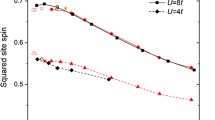Abstract
We study the ground state phase diagram of the two dimensional t — t′ — U Hubbard model concentrating on the competition between antiferro-, ferro-, and paramagnetism. It is known that unrestricted Hartree–Fock- and quantum Monte Carlo calculations for this model predict inhomogeneous states in large regions of the parameter space. Standard mean field theory, i.e., Hartree–Fock theory restricted to homogeneous states, fails to produce such inhomogeneous phases. We show that a generalization of the mean field method to the grand canonical ensemble circumvents this problem and predicts inhomogeneous states, represented by mixtures of homogeneous states, in large regions of the parameter space. We present phase diagrams which differ considerably from previous mean field results but are consistent with, and extend, results obtained with more sophisticated methods.
Similar content being viewed by others
References
M. Imada, A. Fujimori, and Y. Tokura, Metal-insulator transitions. Rev. Mod. Phys. 70:1039 (1998).
E. Dagotto, Correlated electrons in high-temperature superconductors. Rev. Mod. Phys. 66:763 (1994).
E. Demler, W. Hanke, and S. C. Zhang, SO(5) theory of antiferromagnetism and superconductivity. Rev. Mod. Phys. 76:909 (2004).
P. W. Anderson, P. A. Lee, M. Randeria, T. M. Rice, N. Trivedi, and F. C. Zhang, The physics behind high-temperature superconducting cuprates: The ‘plain vanilla’ version of RVB. J. Phys.: Condens. Matter 16:R755 (2004).
P. A. Lee, N. Nagaosa, and X. G. Wen, Doping a Mott insulator: Physics of high-temperature superconductivity. Rev. Mod. Phys. 78:17 (2006).
E. H. Lieb, Variational principle for many-fermion systems. Phys. Rev. Lett. 46:457 (1981).
V. Bach and J. Poelchau, Accuracy of the Hartree–Fock approximation for the Hubbard model. J. Math. Phys. 38:2072 (1997).
J. E. Hirsch, Two-dimensional Hubbard model: Numerical simulation study. Phys. Rev. B 31:4403 (1985).
H. Q. Lin and J. E. Hirsch, Two-dimensional Hubbard model with nearest- and next-nearest-neighbor hopping. Phys. Rev. B 35:3359 (1987).
D. Poilblanc and T. M. Rice, Charged solitons in the Hartree–Fock approximation to the large-U Hubbard model. Phys. Rev. B 39:9749 (1989).
J. Zaanen and O. Gunnarsson, Charged magnetic domain lines and the magnetism of high-Tc oxides. Phys. Rev. B 40:7391 (1989).
J. A. Verges, E. Louis, P. S. Lomdahl, F. Guinea, and A. R. Bishop, Holes and magnetic textures in the two-dimensional Hubbard model. Phys. Rev. B 43:6099 (1991).
V. Bach, E. Lieb, and J. Solovej, Generalized Hartree–Fock theory and the Hubbard model. J. Stat. Phys. 76:3 (1994).
V. Bach and J. Poelchau, Hartree–Fock Gibbs states for the Hubbard model. Markov Processes Rel. Fields 2(1):225 (1996).
E. Langmann and M. Wallin, Restricted path integral approach to the doped Hubbard model. Europhys. Lett. 37:219 (1997).
E. Langmann and M. Wallin, Mean-field approach to antiferromagnetic domains in the doped Hubbard model. Phys. Rev. B 55:9439 (1997).
W. P. Su, Interplay of d-wave superconductivity and antiferromagnetism in cuprate superconductors: Phase separation and pseudogap phase diagram. Mod. Phys. Lett. B 19:1295 (2005).
H. Taniguchi, Y. Morita, and Y. Hatsugai, Magnetism in the two-dimensional t-t′ Hubbard model: From low- to over-doping. Phys. Rev. B 72:134417 (2005).
L. Arrachea, Itinerant ferromagnetism in the two-dimensional t-t′ Hubbard model. Phys. Rev. B 62:10033 (2000).
B. Valenzuela, M. A. H. Vozmediano, and F. Guinea, Inhomogeneous structures in the t-t′ Hubbard model. Phys. Rev. B 62:11312 (2000).
C. Honerkamp and M. Salmhofer, Temperature-flow renormalization group and the competition between superconductivity and ferromagnetism. Phys. Rev. B 64:184516 (2001).
D. Penn, Stability theory of the magnetic phases for a simple model of the transition metals. Phys. Rev. 142:350 (1966).
W. P. Su, Spin polarons in the two-dimensional Hubbard model: A numerical study. Phys. Rev. B 37:9904 (1988).
A. Singh and H. Ghosh, Stability of the doped antiferromagnetic state of the t-t′ Hubbard model. Phys. Rev. B 65:134414 (2002).
M. S. Hybertsen, E. B. Stechel, W. M. C. Foulkes, and M. Schl¨ter, Model for low-energy electronic states probed by x-ray absorption ins high-T c cuprates. Phys. Rev. B 45:10032 (1992).
J. C. Slater, Note on Hartree’s method. Phys. Rev. 35:210 (1930).
P. B. Visscher, Phase separation instability in the Hubbard model. Phys. Rev. B 10:943 (1974).
F. C. Zhang, C. Gros, T. M. Rice, and H. Shiba, A renormalized Hamiltonian approach to a resonant valence bond wave function. Supercond. Sci. Technol. 1:36 (1988).
H. X. Huang, Y. Q. Li, and F. C. Zhang, Charge-ordered resonating bond states in doped cuprates. Phys. Rev. B 71:184514 (2005).
Q. H. Wang, Z. D. Wang, Y. Chen, and F. C. Zhang, Unrestricted renormalized mean field theory of strongly correlated electron systems. Phys. Rev. B 73:092507 (2006).
Y. Nagaoka, Ferromagnetism in a narrow, almost half-filled $s$ band. Phys. Rev. 147:392 (1966).
J. de Woul, A restricted Hartree–Fock study of the 2D Hubbard model. Master’s thesis, KTH, 2007.
Author information
Authors and Affiliations
Corresponding author
Additional information
PACS: 71.10.Fd, 05.70.Fh, 75.50.Ee
Rights and permissions
About this article
Cite this article
Langmann, E., Wallin, M. Mean Field Magnetic Phase Diagrams for the Two Dimensional t — t′ — U Hubbard Model. J Stat Phys 127, 825–840 (2007). https://doi.org/10.1007/s10955-007-9308-y
Received:
Accepted:
Published:
Issue Date:
DOI: https://doi.org/10.1007/s10955-007-9308-y




